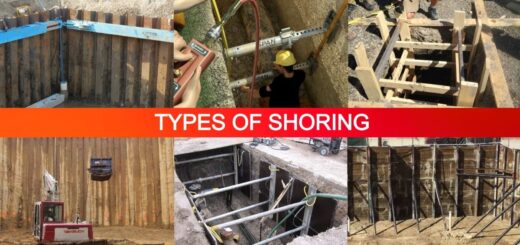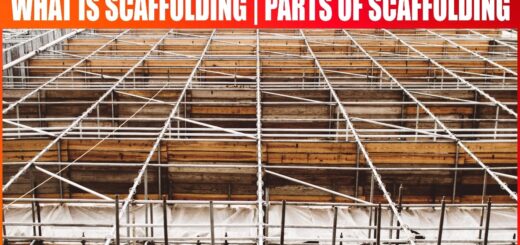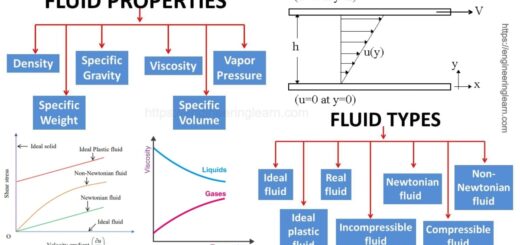What is Vitrified Tiles? 5 Types of Vitrified Tiles, Process of Making, Advantages & Disadvantages [Complete Details]
![What is Vitrified Tiles? 5 Types of Vitrified Tiles, Process of Making, Advantages & Disadvantages [Complete Details]](https://engineeringlearn.com/wp-content/uploads/2023/01/Vitrified-Tiles-1024x539.jpg)
Introduction
What is Vitrified Tiles? 5 Types of Vitrified Tiles, Process of Making, Advantages & Disadvantages: – It is the flooring that assumes a significant part in enhancing the magnificence of the house. Flooring is the biggest surface area in your home that you are trying to cover with gorgeous and durable flooring materials. Whatever flooring materials you have to choose, will significantly impact the overall look and feel of your home. There is an immense assortment of flooring materials that are accessible in the market like marble, fired tiles, terrazzo, mosaic tiles, normal stone, wood, and so on.
These days, vitrified tiles are among the most trending flooring materials that anyone could hope to find on the lookout and are prevalently utilized in the house. Vitrified tiles are extremely notable in various residential and business spaces. These tiles are the best choice to marble and stone. They are utilized both indoors and outdoors because of their aesthetic appeal and good appearance.
What Are Vitrified Tiles?
Vitrified tiles are ceramic tiles that have extremely low porosity and generally utilized outdoor was due to their water and frost resistance properties. Vitrified tiles are made by the combination of silica, clay, quartz, and feldspar. Vitrified tiles are a blend of silica and clay in the appropriate proportion. The fused material is heated at a high temperature which prompts the unique surface of the vitrified tiles. Vitrified tiles seem Glossy and glass-like surface.
Vitrified tiles have more prominent mechanical strength as well as scratch resistance when contrasted with granite or marble. The installation of vitrified tiles is simple when contrasted with different kinds of times and it doesn’t need skilled labor for its installation. The maintenance of the Vitrified Tiles is simple on account of their shining or sparkling surface. Vitrified tiles are smooth in surface and give you an aesthetic inside of the buildings. The water absorption of vitrified tiles is negligible, which is the reason it is suitable for wet areas. Vitrified tiles likewise have high frost resistance as a result of its low water absorption.
Process of Making Vitrified Tiles
Vitrified tiles are produced or manufactured utilizing the blending of different raw materials, for example, clays, quartz, silica, soda feldspar, potash feldspar, china clay, powder, sodium silicate, STPP, different tones, synthetics, and a lot more things. It is manufactured with the assistance of a hydraulic press in which the tiles powder is passed through the press and with the assistance of weighty squeezing the tiles are shaped utilizing different size molds. There are no chemical changes in the vitrified tiles subsequent to assembling.
These tiles are more grounded and solid as they are formed utilizing the Vitrification process in which the tiles are passed through the furnace at a high temperature of around 1200 C. It brings about creating a vitreous or glassy surface which is difficult and polished. This process of manufacturing or assembling is known as the vitrification process.
After that firing process, they are left for cooling for 24 hours. It passes through the polishing and sizing machines where the final surface finish or completion is formed and packed into a corrugated box. There are various thicknesses for various sizes, for the most part, the thickness is 8 to 12 Mm.
Types of Vitrified Tiles
Vitrified tiles are accessible in varieties of designs, patterns, colors, and sizes. It comes in various sorts, for example, twofold charge vitrified tiles, full body vitrified tiles, glazed vitrified tiles, soluble salt vitrified tiles, and so on. In this way, the challenge is to utilize the best-vitrified tiles relying on where it is being used.
1. Double Charged Vitrified Tiles: ( Types of Vitrified Tiles )
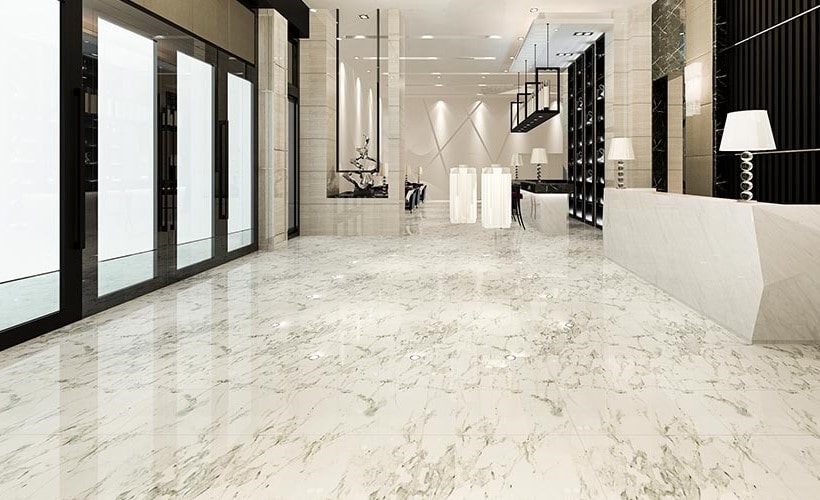
Double charge vitrified tiles are perhaps the most ideal decision which is widely utilized for residential as well as commercial projects. Double charged vitrified tiles are manufactured by infusing the two layers of tiles together which makes them thicker than conventional tiles. The process of vitrification makes the tile surface more grounded and shinier which gives an aesthetic look. Double charge vitrified tiles are solid and scratch-resistant.
Double charge vitrified tiles are utilized in homes corporate places hospital banks and different affiliations etc. Vitrified tiles are budget friendly and generally utilized in the interior of homes and workplaces.
Double charged vitrified tiles are normally 3 to 4 mm thick in size and made by merging two layers of tiles. The double charged vitrified tiles required less maintenance and it forestalls the accumulation of dirt and dust on the outer layer of this style because of which it is exceptionally simple to clean. Double charge vitrified tiles are reasonable for heavy traffic commercial projects. The cost of double charged vitrified tiles is somewhat more when contrasted with polish-glazed vitrified tiles.
2. Glazed Vitrified Tiles: ( Types of Vitrified Tiles )
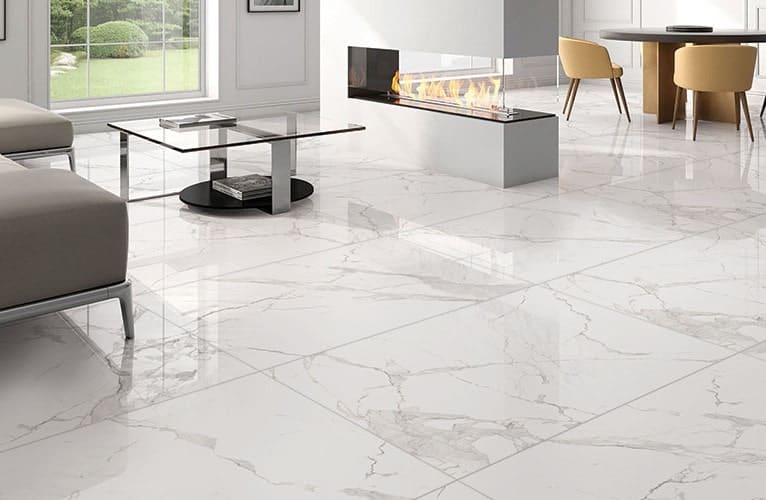
Glazed vitrified tiles have a glazed surface and are produced utilizing digital innovation to accomplish different patterns and appearances on the tile, similar to designs that replicate wood, bamboo, marble, etc. These are the tiles that have made another way to deal with the most recent innovation ie, the digital Printing Machines.
As these tile designs are exceptionally customized and any sort of photographs, pattern, or design can be manufactured utilizing the Inkjet Printing machine. Because of the glaze layer on top of the GVT tiles, you can print any kind of design. Consequently, more options are available. There are different surfaces and finishes accessible for glazed vitrified tiles like glossy, Matt, carving, Metallic, baby satin, Sugar, and some more. The digital layer on the outer surface of the tile is less than 1 mm.
3. Soluble Salt Vitrified Tiles: ( Types of Vitrified Tiles )
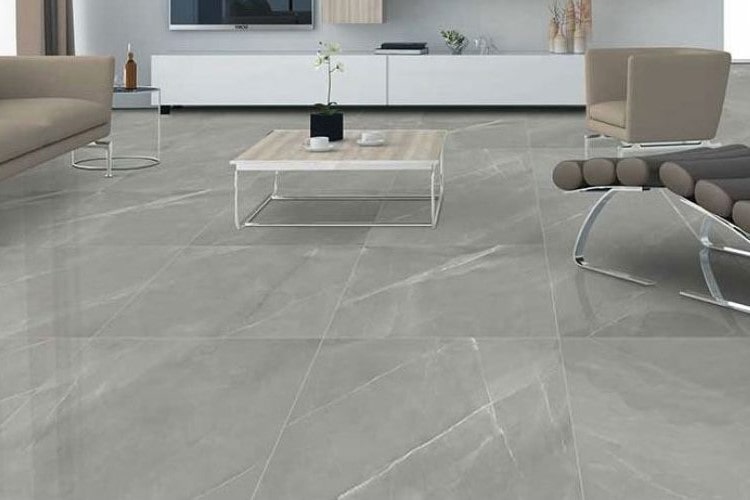
These tiles are made utilizing screen printing innovation in which the soluble salt colors are utilized for making the design utilizing semi-automatic printing machines. Most designs for this kind of tile depend on Ivory color. They are the most affordable vitrified tiles and should be visible wherever from homes to different commercial spaces. These tiles are called nano-polish vitrified tiles as they pass through the nano-coating machine which fills the small holes or pores and creates a superior surface and appearance.
4. Full Body Vitrified Tiles: ( Types of Vitrified Tiles )

The color of full body vitrified tiles is consistent all through their thickness. This is on the grounds that the pigment combination is added right toward the beginning of the production process to accomplish a homogenous color that is uniform all through the tiles. Accordingly, these tiles will never stain or fade in their life expectancy. owing to this feature, full-body vitrified tiles are the most ideal for areas that have high traffic since scratches are scarcely perceptible. Full body vitrified tiles are more expensive when contrasted with double charge vitrified tiles. The price of such types of vitrified tiles might vary with the manufacturer and size.
By all accounts, glazed and full-body vitrified tiles may appear indistinguishable; in this manner, it is basic to review the specialized parameters of these vitrified tiles prior to buying them for your home. The scratches are less recognizable in full body vitrified tiles because of the uniform color throughout the body of the tiles.
5. Polished Glazed Vitrified Tiles (PGVT): ( Types of Vitrified Tiles )

Polished glazed vitrified tiles are equivalent to glazed vitrified tiles with polish on top of it to make them seriously sparkling. It is prominently known as PGVT tiles. They are not that durable when contrasted to double charge vitrified tiles. They are more expensive when contrasted with GVT tiles. The sizes of these sorts of vitrified tiles are practically comparative as of GVT tiles.
How to Choose Vitrified Tiles?
Below are a few parameters for picking the best vitrified tiles for flooring:
- Choose a reputed brand – This can ensure good quality.
- Really look at technical specifications – Ensure the tiles retain something like 0.1% of water by their weight as tiles with less water absorption are tougher and more strong.
- Select the right size of the tile contingent upon the area or the design of the home shared by the architect/interior designer – choose bigger tiles for the living room or washrooms as they enhance the space.
- choose a suitable pattern and color – Remember the theme of your home and pick light colors to offer a spacious look to your place.
- Determine the quantity of tiles – Calculate and purchase somewhere around 10-15 percent extra to deal with the wastage during installation.
Where to Install Vitrified Tiles?
Vitrified tiles are great for use in a washroom or room flooring or backsplash in the kitchen. The vitrification process solidifies and weatherproofs the tiles, permitting them to be utilized in both indoor and outside areas. Furthermore, these tiles can likewise be installed on the rooftop or in the garden since they can endure pressure.
How to Install Vitrified Tiles?
Vitrified tiles have under 0.1% porosity and consequently cannot bond well with the traditional cement-based application. The traditional application will prompt the de-bonding of tiles and lip-page due to non-establishment of holding between the tiles and the substrate. To keep away from this, the recommendation is to utilize tile adhesive which has added polymer content to facilitate the bonding between the two surfaces and evade the previously mentioned impediments. It is suggested that tile adhesive depend on the requirements and substrates and adhere to Indian and European guidelines.
How to Maintain Vitrified Tiles?
The intrinsic characteristics of vitrified tiles make them resistant to stains. Thus, these tiles are exceptionally easy to clean and maintain, requiring just water and fundamental cleaning solutions. Besides, the grout between the tiles must be carefully chosen to ensure maximum life and of the tile joints and increment the aesthetics of the room. For tile joint fillers, explore the product range of cement or epoxy-based grout fillers by Roff, India’s driving organization offering progressed tile and stone fixing solutions.
Advantages of Vitrified Tiles
- Low Water absorption – As the tiles are non-porous it is appropriate for wet regions. It has under 0.5 % water absorption.
- Low porosity – Vitrified tiles are prepared in high temperatures they are less porous tiles.
- Durability or Sturdiness – They are very solid because of their strength and finish.
- Resistance – They are without stain, high resistance to scratches, and moisture resistance. It additionally has thermal shock resistance.
- Quality – Vitrified tiles have good quality and style.
- Accessibility – It has various colors, designs, and patterns accessible in vitrified tiles.
- Easy maintenance and installation – Vitrified tiles are not difficult to clean and keep up and easy to install and under 48 hours to set. Cleaning is simple as it very well may be finished with the assistance of water and cleaning agents.
- Reasonable – Various types of tiles are accessible in vitrified tiles. It gives different choices with respect to the costs of tiles.
Disadvantages of Vitrified Tiles
- Expensive – One of the significant impediments is that they are more costly when compared with the cost of ceramic tiles and porcelain tiles.
- Installation – Tile laying requires skilled workers and proper guidance. Appropriate adhesive and spacers might be required relying on ceramic tiles. Proper handling of the tiles ought to be taken if not the edges may crack and have chipping issues.
- Slippery –The vitrified tiles when wet are slippery and dangerous so proper consideration ought to be taken.
- Grout – Grout is filled between two tiles for a superior appearance, yet over the long haul the grout will become dirty and should be resealed. The joints between the tiles ought to be neat and the equivalent for every one of the areas.
Conclusion
As the tiles are versatile, less maintenance and durable they are the best options in contrast to the granite and quartz flooring. These tiles are highly suggested by interior designers, builders, and consumers as they have many features which are better than ceramic tiles. Vitrified tiles are prevalently made of a combination of clay and silica, feldspar and quartz. When heated at a high temperature, these materials fuse together, leading to areas of strength, and resistant tiles. Glazed vitrified tiles and full body vitrified tiles may nearly appear to be identical; subsequently, it is essential to check the technical specifications of the vitrified tiles before you purchase them for your home.
There are various kinds of vitrified tiles and choosing the right one has a significant effect. Each sort of vitrified tile are the most appropriate for specific necessities and in this manner knowledge about the various kinds of vitrified tiles can give you an idea regarding which vitrified tile are best for your purpose.
Content Source: – civiljungle, mccoymart, ceramictilesblog, gharpedia
Image Source: – decorcera, kajariaceramics, lavishceramics, sakarmarbo
